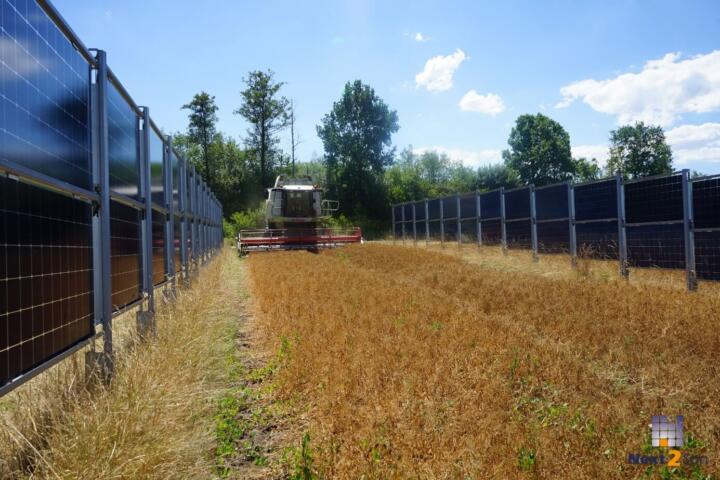Double benefit
Sometimes it takes a little longer for innovative ideas to gain traction. In this case, it even took several decades: as far back as in 1981, German scientists Adolf Götzberger and Armin Zastrow published an article titled “Kartoffeln unter dem Kollektor” (“Potatoes underneath the collector”) in the “Sonnenenergie” trade magazine in which they calculated the advantage of photovoltaic (PV) systems installed above areas of arable land. Afterwards, however, the concept was shelved again. High costs, non-profitability and lack of research about the impact on crops were some of the reasons. It took until shortly after the turn of the millennium for initial projects to be translated into reality. Thanks to technological progress photovoltaic cells can now be produced at lower costs and government funding provides further incentives. Due to climate change and its consequences, agrivoltaics – a term coined in 2011 – has been gaining additional importance.
The reason is that solar alongside wind power is a crucial factor for the successful departure from fossil energy. However, many countries hardly have any unused areas left on which PV systems could be installed. That’s where agrivoltaics comes into play. The dual use of areas for farming and energy production does not engender competition between these two purposes but even creates valuable synergies and is a lucrative proposition because agri-PV increases land use efficiency by 60 percent: farmers can diversify their potential income, supply themselves with solar power and drive their decarbonization efforts.
Three types of agri-PV
Currently, a differentiation is made between three versions of agri-PV systems. Systems mounted on high stilts are installed horizontally above the fields. The shading of the plants decreases evaporation and increases the soil’s water storage capacity, which can reduce the consumption of water by up to 20 percent. That’s an important aspect particularly for regions prone to droughts.
“Agrivoltaics has great potential to mitigate the negative effects of climate change, especially of droughts, on crop yield and can thus help enhance the resilience of agricultural production and food security under changing environmental conditions.”
Researchers in a study at the University of Hohenheim
In addition, this type of system provides protection against other climatic effects such as hail or heavy rain. Using purpose-built modules, the collected rainwater can be stored and systematically distributed on the fields. Stilts of adequate height also enable the utilization of large machines such as combines. However, the installation of such systems is complex and costly. The Fraunhofer Institute for Solar Energy Systems (ISE) has even come up with the following calculation: in Germany, the capital expenditures incurred for agri-PV substructures in arable farming of an area of 2 hectares (5 acres) amount to an average of 372 euros/kW compared to 76 euros/kW for conventional ground-mounted PV systems.
A lower-cost alternative is vertical systems installed between farm fields. The gaps between the rows are selected in a way that enables the utilization of agricultural machines. The fact that they serve as wind breakers and the usability of the rows of posts for biodiversity and biomass strips are additional advantages of vertical systems. However, they’re suitable only for low-growing crops because taller plants would cover the PV panels and reduce the electricity yield. The third type of system has so-called trackers that orient the PV modules according to the sun. Throughout the day, they change their incidence angle in order to catch as much light as possible or to adjust to electric power requirements.
Breaking new technological and scientific ground
Because agrivoltaics is still in its infancy some questions remain to be answered. What type of system is the most efficient one? What crops are best-suited? Agri-PV farms are already operating regularly worldwide, with nearly 2,000 of them installed in Japan making that country the front runner in this field. Even so, research continues in numerous pilot plants that often produces amazing results. Especially dry regions with scarce precipitation have shown positive outcomes. In Arizona, for instance, the yield of cherry tomatoes grown under systems mounted on high stilts doubled and those of bird peppers even tripled. In a study conducted in Kenya, water consumption was reduced by 47 percent while the size of cabbages increased by almost a quarter. By contrast, the cultivation of certain crops underneath the PV covers poses a problem because the shade causes up to 30 percent of the light required for photosynthesis to be lost. During tests in Germany just minor shading of crops like corn or soy beans resulted in significant crop yield losses. In addition, in many countries the legal frameworks for implementing agrivoltaics without a lot of red tape are still lacking.
Rapid development
Even so, the development of agrivoltaics is taking place at a fast pace. Installed capacity worldwide went up from some five megawatt-peak (MWp) in 2012 to 14,000 MWp in 2021 – equating to a capacity of roughly 14 coal-fired block-unit power stations.
Experts regard bifacial PV modules absorbing light from both the top and bottom, thus using diffuse light as well as light reflected by the ground or by plants, as game changers. As a result, they produce up to 25 percent more electric power than conventional PV modules. They currently account for less than one third of the world market share in photovoltaic modules, but experts expect that to increase to more than 60 percent by 2030.

All that clearly shows the huge overall potential of agrivoltaics. Consequently, its deployment can be a key factor of the energy transition process: its use on just one percent of the worldwide farmland could cover the entire current global power consumption, according to studies.







